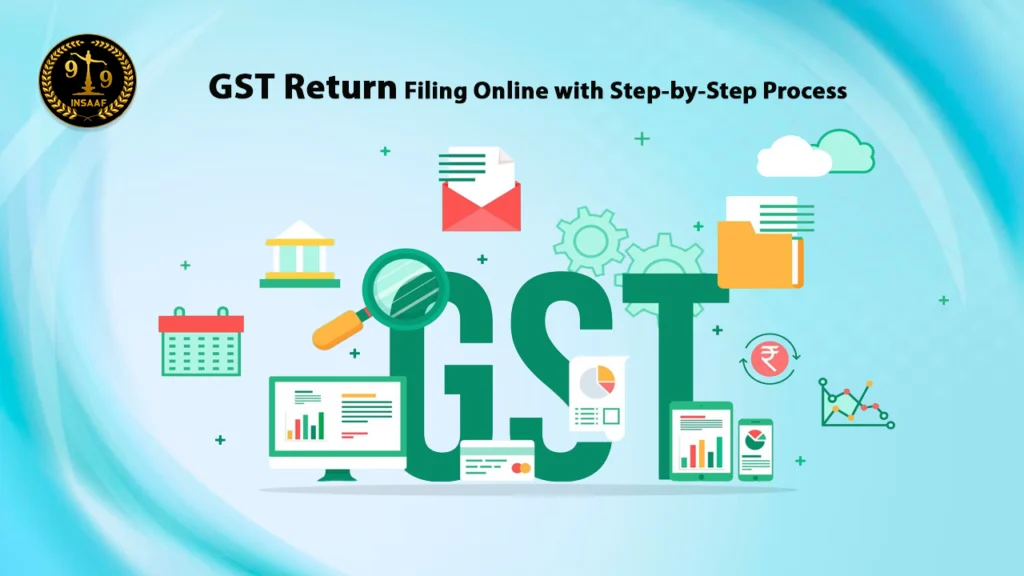

Online Legal Advice from Insaaf99® Online Lawyer Consultation in India


Online Legal Advice from Insaaf99® Online Lawyer Consultation in India

GST is an exhaustive Indirect tax reform that replaced multiple indirect taxes in India covering goods as well as services. It has substituted multiple indirect taxes like VAT, Service Tax, Excise Duty, Etc. charged by the central and state governments, in its effort to come up with a single layer of taxes.
Filing GST in India is quite simple and can be easily done online, you need to have a registered GST number known as GSTIN. The official government portal for GST website (www. gst. gov. in) allows easy GST filing, there are various options available based on the nature of the business, you need to select the correct category and form for filing GST. The compliance with tax laws call for early filing of returns so as not to attract penalties. In this article we explain the method of filing GST in details, however, it is recommended to meet a tax consultant or use the GST filing tools.
Filing GST returns is crucial for businesses for several reasons and some key reasons are listed below
Legal Requirement: In accordance with GST legislations, the registered dealers have to furnish GST returns periodically.
Input Tax Credit: As every businessman is aware, proper filing will enable the company to claim input tax credit thus lowering the tax that it needs to pay.
Compliance: Filing of GST returns is important in fulfilling the legal requirements of paying taxes and staying away from complicated laws.Â
GST returns are regular reports that taxpayers submit to tax officials. These reports list their sales, purchases, and what they owe in taxes. These returns play a key role in figuring out how much tax someone needs to pay or get back.
GST returns are filed using different forms, each serving specific purposes:
GSTR-1: Taxpayers file this return to report their sales of goods and services during a tax period. It has details of invoices they issue, credit or debit notes, and exports.
GSTR-3B: A simple return that lets taxpayers figure out their own tax bill based on what they buy and sell. Most file it, but some can do it every three months.
GSTR-2A: The GST portal makes this return on its own. It shows what a business bought, as reported by their suppliers in their GSTR-1.
GSTR-2B: This is a view-only version of GSTR-2A. Businesses use it to claim input tax credit.
GSTR-4: Businesses under the composition scheme file this return every three months.
GSTR-5: Non-resident taxable persons use this return.
GSTR-6: Input Service Distributors (ISD) use this return.
GSTR-7: This return is for those who deduct TDS/TCS.
GSTR-9: This yearly return sums up all supplies, taxes paid, and input tax credit claimed during the financial year.
GSTR-9C: Businesses that opt for the presumptive income scheme use this to match up their numbers.
Note: The way you file GST returns can change. To get the right info always check the latest rules from the GST authorities.

GSTR-1: Normal taxable individuals who are the suppliers of goods or supplier of services or the registered dealers under the export category or normal taxpayers who have opted for monthly or quarterly returns.
GSTR-3B: Every form of a normal taxpayers needs to file GSTR-3B on a monthly basis.
GSTR-4: The registered taxpayers who opted for composition levy that follows quarterly filings of returns.
Before initiating the GST return filing process, ensure you have the following documents and details ready:
Digital Signature: A digital signature is a cryptographic method to verify the authenticity of electronic documents. It acts as an electronic equivalent of a handwritten signature, used for filing GST returns, refund applications, and legal documents.
E-Way Bill: An E-Way Bill is a mandatory electronic document for the movement of goods worth more than a specified threshold. It ensures GST compliance during transportation.
Meeting GST return filing deadlines and complying with regulations are critical for businesses:
Avoid Penalties: Failure to file GST returns or doing it after the stipulated time leads to penalties as well as interests.
Input Tax Credit Claims: On-time filing assists businesses to avail input tax credit (ITC) on all the purchases made by the business.
Legal Compliance: Filing Goods and Services Tax returns as per schedule to make sure that appropriate term and condition of GST is met.
Complete Payment: Follow the prompts to finalize the payment quickly and efficiently.
These steps ensure a smooth and accurate GST return filing process, helping you stay compliant with GST regulations.
Mistake: Differences observed in the sale returned in GSTR-1 and the sale reported in GSTR-3B can culminate in notices and penalties from the tax authorities.
Solution: Cross-check your sales reports with the invoices created and, further, the entries in GSTR-1 must tally with GST-3B.
Mistake: Filing the GST returns after the due date becomes very costly affairs in terms of fee and levy of interest entirely draining your cash flows and tends to degrade your GST compliance score.
Solution: Calendars for GST return due dates can be prepared and it should be tried to file for it much ahead of time. It is advisable to look for software and tools that can alert you of the approaching due dates, and other related things that can help you in filing in time.
Mistake: Some of the general mistakes include wrong computation of the tax rate, improper classification of the goods or the services being rendered or simple math mistakes.
Solution: Verify tax rates of the product or service you offer and reassess the GST slab under which they fall. Opt for proper GST calculation tools or accounting software so that manual errors are reduced and the calculations done are checked.
Maintain Accurate Records: It is necessary to maintain all the records of the transactions that have been conducted in the business such as invoices, purchase orders, and receipts, as this assists in easy reconciliation.
Regular Reconciliation: For sales and purchase transactions, you may want to do a reconciliation check on a monthly basis to ensure that there are no issues.
Stay Updated: It is recommended to remain informed on any updates in GST laws and acts that may apply to the business.
Use Technology: Make use of accounting software that is indented to meet the requirement of the GST. They have features that can calculate the amounts; set reminders and due dates, and prepare error-free returns eliminating possibility of human errors.
Consult Experts: In case you have any doubt about any single aspect of the GST filing, it is always better to take advice from a GST consultant/tax advisor/attorney.
Filing of GST returns with accuracy and within the appropriate time is very essential to avoid attracting penalties. It is crucial to ensure discernment of the following common pitfalls and the accompanying actions outlined in this guide which will help enhance the flow of GST compliance.
Do not forget to take into account that precise records, tools that are provided, and the appeal to professional help in case of necessity can make the GST return filing process easier.
Adhering to GST compliance always helps in facilitating the flow of the tax system, and at the same time, strengthens the basic infrastructure for the growth of your business.
FAQs